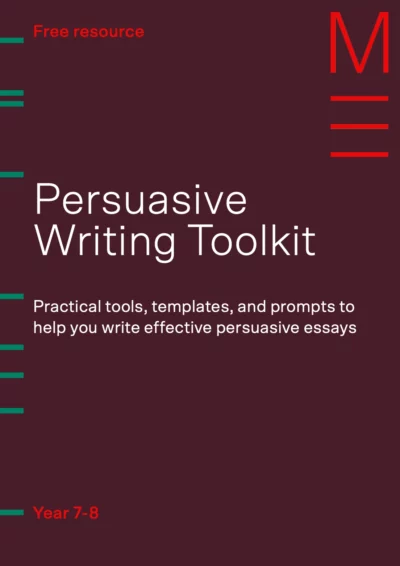Welcome to Matrix Education
To ensure we are showing you the most relevant content, please select your location below.
Select a year to see courses
Learn online or on-campus during the term or school holidays
Learn online or on-campus during the term or school holidays
Learn online or on-campus during the term or school holidays
Learn online or on-campus during the term or school holidays
Learn online or on-campus during the term or school holidays
Learn online or on-campus during the term or school holidays
Learn online or on-campus during the term or school holidays
Learn online or on-campus during the term or school holidays
Learn online or on-campus during the term or school holidays
Learn online or on-campus during the term or school holidays
Select a year to see available courses
Science guides to help you get ahead
Science guides to help you get ahead
Ready to write an effective persuasive text? Learn about persuasive writing structure, techniques, and prompts to express your ideas clearly and confidently.

Join 75,893 students who already have a head start.
"*" indicates required fields
You might also like
Related courses

Join 8000+ students each term who already have a head start on their school academic journey.
Want to write more convincing essays for English? In this article, we’ll break down how to write a persuasive text that’s clear, convincing and gets you high marks in your English assessments.
Persuasive writing is all about getting your audience to embrace a particular viewpoint or take a specific action. But, many students struggle with persuasive writing because they either use weak evidence, forget who they’re writing to, or don’t know how to structure their ideas well.
To do well in high school English, you need to take a clear stance, back it up with solid evidence, and use the right techniques. Here’s our guide on how to write a persuasive text.
Table of contents:
Persuasive writing is a form of writing used to convince someone to agree with your opinion or to take a specific action. You’ll see it in speeches, essays, ads, opinion pieces, and even marketing materials.
In high school English, your goal is to persuade your reader by using clear reasons and strong evidence.
To do this well, you need to think about your audience: What matters to them? What could change their mind? The most effective persuasive writing is clear, logical, and appeals to BOTH emotion and reason.
A clear persuasive writing structure helps your ideas flow and makes your argument easier to understand. Most persuasive texts follow this simple structure:
Introduction
Body paragraphs
Conclusion
Get persuasive writing prompts, templates, annotated examples and a self-assessment checklist to start writing like a pro.
A free toolkit to help you plan and write effective persuasive essays, with 10 practice prompts Fill out your details below to get this resource emailed to you. "*" indicates required fields
Persuasive writing made simple!

Persuasive writing made simple!
| Argument | Your persuasive writing text must include an argument. This includes a thesis (main idea) and supporting points that lead to a logical conclusion. |
| Thesis | A thesis (also called a conclusion) is your main argument (idea or opinion). It needs to be clear and specific enough that someone could disagree with it. It usually expresses a relationship, trend or pattern. For example, you may argue for or against a particular position, point of view or belief. You may also express what you’re trying to convince your audience to do. Example: “Social media is harmful to teenagers.” |
| Points | Points are the reasons that support your thesis. |
| Counterarguments | Addressing opposing views (and showing why yours is stronger) makes you more convincing and shows your critical thinking skills. |
| Evidence | This is anything that supports your points, like facts, statistics, expert opinions, or real-life examples. Choose your evidence carefully to make your argument stronger. |
| Argumentation | This is the thinking behind your writing. It’s the way you connect your points to reach your conclusion and persuade the reader that your stance makes sense. |
Authority in persuasive writing comes from sounding credible and knowledgeable. When your audience trusts you, they’re more likely to believe what you’re saying.
Authority: A composer or a trustworthy, reliable, and accurate text.
You can show authority in your writing by:
Sometimes a writer already has authority because of their reputation. But even if you’re not an expert, you can build authority in your writing by showing a strong understanding of the topic and using a confident tone.
Your text can also have authority if it uses evidence that:
In short, if you want your reader to take you seriously, your writing needs to sound informed, thoughtful, and trustworthy.
HSC writing strategies from expert English teachers
Band 6 resources to get you exam-ready. Join the 96% of our students that have improved their marks.
The ancient Greek Philosopher Aristotle identified three key ways to persuade an audience. These are called rhetorical appeals, and you’ll use one or more of them in almost every persuasive text.
When writing a persuasive text, you should use at least one or a combination of rhetorical appeals to convince your audience.
Let’s look at how we would use each of these in the example below.
Ethos is when you try to earn your audience’s trust. You do this by showing that you know what you’re talking about or by using reliable sources.
For example, a scientist giving a speech about the dangers of microplastics might mention her research or qualifications to show she’s an expert.
NOTE: Having credibility is not the same as having authority, and it can depend on the context.
Logos is when you use facts, data or logical reasoning to make your point. This works well for topics that need scientific proof or hard evidence. For instance, if you need to prove that something exists (like climate change or the health risks associated with smoking cigarettes), it would help to point to scientific evidence, data and statistics to prove this definitively.
Example thesis: The government should ban cigarettes.
Logos appeal: Research shows that smoking increases the risk of serious diseases and lowers overall health.
Pathos tries to make your audience feel something (like empathy, anger or fear). While this method doesn’t rely on evidence, it can be very powerful, especially in moral or ethical debates. When you evoke strong feelings, you can use these emotions to effectively persuade an audience to do something.
For example, sharing a story about a family losing someone to a smoking-related illness can really hit home, and make readers more likely to support a cigarette ban.
You don’t have to use all three in every piece, but combining them can make your writing more convincing. The best persuasive texts use a thoughtful mix of ethos, logos, and pathos to connect with the reader and drive the message home.
Three rhetorical appeals summary table:
| Ethos (Credibility) | Builds trust by showing expertise or using reliable sources |
| Logos (Logic) | Uses facts, data, or reasoning to support an argument |
| Pathos (Emotion): | Appeals to the reader’s feelings like fear, empathy, or anger |
When writing persuasively, don’t forget to use other literary techniques you see in English. Similes, metaphors, and imagery can make your arguments more powerful and memorable.
Let’s take a look at an excerpt from Martin Luther King Jr’s famous ‘I Have a Dream’ speech as an example:
“I have a dream that one day even the state of Mississippi, a state sweltering with the heat of injustice, sweltering with the heat of oppression, will be transformed into an oasis of freedom and justice.”
Throughout his speech, the speaker aims to persuade his audience to believe in the vision of a fairer, more equitable society transformed by racial justice. He uses a metaphor to describe social injustice as something physical and uncomfortable: heat.
For example, he describes Mississippi as “sweltering” with the “heat of injustice” and the “heat of oppression”, helping the audience feel the suffocating experience of racial discrimination. The speaker then contrasts that with an image of “an oasis of freedom and justice”. This creates a strong emotional impact and powerfully expresses hope for an equitable future for Black Americans.
We study examples of effective persuasive texts like this so that we understand how to use rhetorical appeals. By using vivid language like this, persuasive writing becomes more than just convincing; it becomes moving.
Try using similar techniques in your writing to express your ideas more deeply and leave a lasting impression.
Here’s a toolkit of techniques you must use if you want to make a convincing argument (and score top marks):
Rhetorical questions
“Do we really want future generations to suffer from our mistakes?”
Inclusive language
“We all have a responsibility…”
Repetition
Reinforces a key message: “We must act. We must change. We must care.”
Emotive language
Words like “devastating,” “injustice,” and “unforgivable” stir emotions.
Metaphors and analogies
Helps visualise complex ideas: “Social media is a ticking time bomb.”
For more information on what English markers are looking for in your persuasive texts, read our Year 9 Guide to Persuasive Writing.
Matrix students learn how to write persuasive texts in structured lessons with expert English teachers. You’ll even get valuable, personalised feedback to help you refine your essays and find your voice.
Learn with expert teachers
Get ahead with courses led by subject matter experts. See why 8000+ students trust Matrix every term.
Written by Matrix English Team
The Matrix English Team are tutors and teachers with a passion for English and writing, and a dedication to seeing Matrix Students achieving their academic goals.© Matrix Education and www.matrix.edu.au, 2025. Unauthorised use and/or duplication of this material without express and written permission from this site’s author and/or owner is strictly prohibited. Excerpts and links may be used, provided that full and clear credit is given to Matrix Education and www.matrix.edu.au with appropriate and specific direction to the original content.